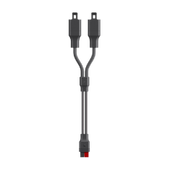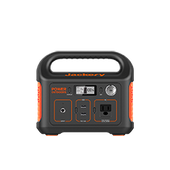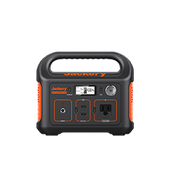What Is An 18000W Generator?
An 18000-watt generator is a large-capacity charging solution that can charge most home or outdoor appliances during long hours. It can power refrigerators, lights, phone chargers, air conditioners, furnaces, and other appliances during long-term power outages, large construction sites, off-grid living, and RV trips.
Generally, there are three types of 18000-watt generators that are fueled by propane, gas, and solar. The choice of the best 18000-watt generator will depend on your needs, preferences, and budget.
18000 Watt Portable Generator: These portable generators typically run on gasoline or propane and deliver a reliable power source for appliances on construction sites and extended RV trips. While the generators with an 18000W capacity are heavy, they generally have wheels to move them from one place to another.
18000 Watt Solar Generator: Solar generators are reliable and eco-friendly charging solutions for those looking to lower their carbon footprint and save on high electricity bills. They are ideal if you want to live off the grid or are dealing with long-term power outages. While the initial costs are higher, they are cost-effective solutions in the long run.
18000 Watt Inverter Generator: The 18000-watt inverter generator delivers safe and stable power to charge sensitive electronics such as laptops and phones. It is generally quieter and fuel-efficient than traditional generators available on the market.
Before you invest in the 18000W generator, it's essential to understand the different terms related to its wattage.
Running Wattage: The running watts are the continuous power the appliance needs to run. A standard LED light's running wattage is typically around 10W. However, a central air conditioning unit will require around 4000W of running wattage.
Starting Wattage: The starting watts are the extra power an appliance requires during the initial start-up. For instance, motorized appliances such as air conditioners and refrigerators need additional power for a few seconds.
Surge Wattage: The surge or peak wattage is the maximum power a generator can provide for a few seconds to start heavy-duty appliances. The Jackery Portable Power Stations' surge wattage is typically twice its rated wattage, so you can run most appliances for hours.
Watt-Hours: The watt-hour is the amount of energy a portable power station or solar generator can deliver over time. It also determines the appliance's power consumption in one hour.
What Can An 18000-Watt Generator Run?
A generator of 18000W capacity can run almost all household appliances during power outages or off-grid living. For example, when there is a long-term power cut in your area, you can power refrigerators, lights, fans, space heaters, sump pumps, air conditioners, microwaves, etc., with the 18000-watt portable generator. It can also charge heavy-duty power tools, such as air compressors, electric saws, and even cement mixers on large construction sites.
Will An 18000 Watt Generator Run A House?
Yes, an 18000W is one of the largest capacity generators that can charge most appliances in a household. For example, you can keep lights on, cool the home with an air conditioner, or keep the food fresh in the refrigerator when the electricity grid is down. Hence, the 18000-watt generator is ideal for keeping necessary appliances charged during extended power outages.
Additionally, many people who are looking to go completely off the grid and save money on high electricity bills can consider investing in the powerful 18000W generator. An 18000W generator can charge most household appliances for hours, ensuring your off-grid experience remains comfortable.

Can 18000 Watt Generators Be Used For Heavy-Duty Power Tools?
Yes, an 18000-watt generator is capable of charging heavy-duty power tools such as electric saws, drills, compressors, pressure washers, and even welding machines. However, you'll need to look for a large generator with wheels and a pull rod to move the heavy charging solution to construction sites and power appliances.
Is An 18000 Watt Generator Enough For an RV?
Yes. A 2000W to 12000W generator is typically sufficient to charge campers, RVs, travel trailers, pickup trucks, and SUVs. However, if your power needs are higher or you are planning an extended RV trip in a campground with no power outlets, you may consider investing in the 18000-watt portable generators. They can charge heavy-duty RV appliances, such as air conditioners, space heaters, freezers, electric stoves, freezers, ice makers, etc.

Can You Live Off-Grid With An 18000W Generator?
Yes, an 18000W generator supports off-grid living by powering essential household appliances, such as refrigerators, air conditioners, televisions, sump pumps, CPAPs, lights, etc. If you're looking for a reliable charging solution for off-grid living, investing in the best 18000-watt solar generator is worth it. These generators combine solar panels and portable power stations to collect, convert, and supply electricity to off-grid appliances whenever and wherever required.
Jackery 18000W Portable Generator
Jackery does not currently have an 18000W output generator, but you can build a 6000W output generator by combining a 2*Jackery Explorer 2000 Plus Portable Power Station in a parallel connection. If you want more power, the Jackery Explorer 2000 Plus Portable Power Station can be expanded from 2kWh to 24kWh with Jackery Battery Pack 2000 Plus. If you're still unsure which solar generator is ideal for your needs, we will reveal two popular Jackery Portable Power Stations here.
Jackery Explorer 2000 Plus Double Kit
The Jackery Explorer 2000 Plus Double Kit is a powerful, portable charging solution that simultaneously charges up to 18 devices. It often involves connecting 2*Jackery Explorer 2000 Plus Portable Power Station in parallel to increase the capacity and charge 99% of household or outdoor appliances, including air conditioners, refrigerators, coffee makers, microwaves, sump pumps, etc. You can choose the portable power station to charge appliances when there is an extended power outage, or you're planning a short outdoor trip.

Jackery Solar Generator 2000 Plus Kit (24kWh)
If you're looking for a solar generator that can meet the power demands of off-grid living or large construction sites, you may consider this ultra-powerful Jackery Solar Generator 2000 Plus Kit (24kWh). The power master can charge 99% of small to large appliances, including chainsaws, bench grinders, microwaves, electric drills, large water heaters, etc. You can also connect the portable power station to the home circuit to start charging the essential appliances in the blink of an eye during power outages.

|
Product |
Output Rated / Surge Watts |
Capacity |
Appliances Running Time |
|
Jackery Explorer 2000 Plus Double Kit (6000W/240V/4kWh) |
6000W /12000W Surge Peak |
4085.6Wh |
Electric Grill (1500W): 2.3H Dishwasher (1500W): 2.3H Microwave (1200W): 2.8H Coffee Maker (1000W): 3.4H Blender (300W): 11.5H |
|
Jackery Solar Generator 2000 Plus Kit (24kWh) |
6000W /12000W Surge Peak |
24513.6Wh |
Electric Grill (1500W): 13.8H Dishwasher (1500W): 13.8H Microwave (1200W): 17.3H Coffee Maker (1000W): 20.8H Blender (300W): 69.4H |
What Is The Most Portable 18000 Watt Generator?
An 18000W generator with wheels and handles is generally considered more portable compared to traditional charging solutions. Despite the high capacity of the 18000W generator, the wheels and ergonomic handle of the generator can significantly improve mobility.
If you're looking for a generator that combines portability and functionality, you may consider the Jackery Solar Generator 2000 Plus Kit (24kWh). The Jackery Explorer 2000 Plus Portable Power Station's double wheel, pull rods, and foldable handles make it easy to move around and charge appliances on the go.
How Many Amps Does An 18000-Watt Generator Produce?
An 18000W generator is a powerhouse that can produce 150 amps at 120V or 75 amps at 240V. It can be calculated using the simple formula: Watts = Amps × Volts. According to the formula, the amps are inversely proportional to the voltage when the wattage remains the same. The following section will reveal how to calculate the generator’s amp, which operates at 120V and 240V, respectively.
At 120V:
Amps = Watts ÷ Volts = 18000W ÷ 120V = 150A
At 240V:
Amps = Watts ÷ Volts = 18000W ÷ 240V = 75A
Let's take another example:
Suppose you have the Jackery Solar Generator 2000 Plus with a battery capacity of 2042.8Wh and operates at 44.8V. The amp-hour of the solar generator can be calculated using the following formula:
Amp-Hour = Watt-Hour ÷ Volts = 2042.8Wh ÷ 44.8V = 45.6Ah
What Size Generator Do I Need?
The size of the generator you need depends on the power requirements or the wattage of the appliances you're charging simultaneously. For example, if you're planning to go fishing or hiking, you’ll need a small portable power station with 500 - 1000W capacity. On the other hand, you'll require 5000 - 7000W to run most household appliances during extended power outages or blackouts.
Here's the step-by-step process to determine the right solar generator size for your needs.
Step 1: The first step is to note down the appliances you plan to charge simultaneously with the solar generator.
Step 2: Find the total running wattage of all the listed appliances you would like to charge. Generally, the wattage information is available in the user manual or on the device itself, or it can easily be calculated by multiplying the volts and amps.
Step 3: Finally, find the appliance with the highest starting wattage and add the number to the total running wattage.
Check out the example here:

FAQs
How much can an 18000-watt generator run?
An 18000-watt generator can charge a variety of appliances, including small to large air conditioners, furnaces, well pumps, air compressors, table saws, corded power tools, and more. It can be used to charge appliances during extended power outages, off-grid living, large construction sites, and long RV trips.
Can we run 1.5-ton AC on a generator?
Yes, a 1.5-ton AC can be run on a generator. However, the generator should be powerful enough to meet the energy demands of a 1.5-ton AC (1500 - 1800W). A generator producing at least 3000 - 5000W is recommended to charge a 1.5-ton AC for long hours.
How many watts is the biggest generator?
There are different sizes of generators available in the market, the largest of which are over 500,000 watts. However, they are typically used for commercial or industrial purposes with large power needs. A typical household would require anywhere around 2000W - 7000W of generator.
Conclusion
Buying an 18000-watt generator requires a huge investment, and choosing the right-sized generator can help you save a lot of money. If you're planning to buy a generator, the first step is to determine the power consumption of the appliances and the capacity of the generator.
An 18000W generator is a decent-sized generator for household, camping, or worksite appliances. If you're still not sure what size power station would meet your needs, you may go ahead with the expandable Jackery Explorer 2000 Plus Portable Power Station. It supports an additional Jackery Battery Pack 2000 Plus to extend the battery from 2kWh to 24kWh.





















































































































Leave a comment